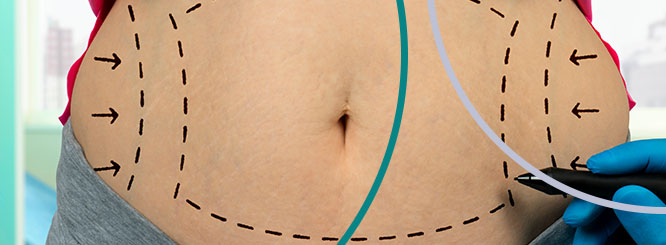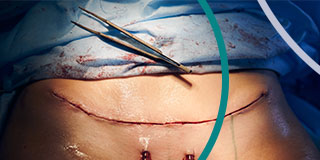
The abdominoplasty, better known as the tummy tuck, is one of the most popular cosmetic surgeries today. Patients who qualify for this surgery are usually looking to remove excess skin that results from extreme weight loss, pregnancy, or age. The tummy tuck procedure helps tighten the abdominal muscles and gives the stomach a flatter, tauter appearance that may not be achievable through physical activity alone.
For more information on the tummy tuck, we invite you to read this article where we go into full detail about the preoperative process, how the procedure is carried out, the possible risks, and what the recovery entails. An important section of the article is the one that explains the different types of tummy tucks, where you’ll be able to read that not all procedures are the same. Some, like the mini tuck, require a small incision and the results are not as extreme as the partial or complete tummy tuck, whose procedures may include other types of surgeries, such as a butt lift or liposuction.
Liposuction is also a very popular weight loss procedure and while most patients may only need a tummy tuck, the question of whether a lipo is necessary after the abdominoplasty also arises. At LIMARP®, Dr. Liza María Pompa González and our certified plastic surgery team review your medical history to guide through all the available options and ensure that you get the best treatment possible. This article takes a closer look at the liposuction procedure, its pros and cons, and if it’s a viable option after getting a tummy tuck.
Liposuction: How is it done?
A liposuction is a procedure commonly used in plastic surgery to remove fat and while it’s considered to be generally safe, not all surgeries are equal because they depend on the amount of fat that’s being removed and the anesthesia (general, regional, or local) that will be applied. Surgeons use a cannula and negative pressure to suck out the fat and the techniques may vary according to how the cannula works or if the removed fat will be used as a filler for other parts of the body.
Although liposuction is one of the most popular cosmetic surgeries, there are studies that conclude that it’s not an effective remedy for long term weight loss and it doesn’t affect obesity-related conditions. After recovery, the body’s overall fat returns as it was before the surgical procedure, regardless of diet and exercise regime, and the increase is most notably on the abdominal area. The patient may also experience excess visceral fat around the internal organs which can cause other diseases such as diabetes.
The downsides of liposuction to treat weight loss are well known, but this procedure is still used for aesthetic improvements and body contouring. As we mentioned before, it’s common for certain tummy tucks to include liposuction in order to achieve a certain look, and while many patients have found that lipo is not necessary after getting an abdominoplasty, others do consider taking that route.
Liposuction After Getting a Tummy Tuck
It’s important to establish that while liposuction is common during a partial or complete tummy tuck, it’s not done on the abdominal area, but on the hips, flanks, and pubic area to achieve the lean and toned appearance many patients strive for after the surgery. Liposuction on the upper abdomen is commonly performed because the patient may experience weight gain in that area after the abdominoplasty, while the lower abdomen remains flat. It’s recommended that the patient waits three to six months until they’re fully healed to get liposuction, but keep in mind that the procedure alone won’t provide long-term results.
If you’re experiencing weight gain after your tummy tuck procedure, contact your surgeon to know if liposuction is the best solution for you.
Contact Us to Learn More
If you’ve recently gotten a tummy tuck and want to know if liposuction is an option for you, schedule an appointment with one of our doctors. We can help determine the right treatment for you. Contact us online anytime or give us a call at (619) 373-0229.


